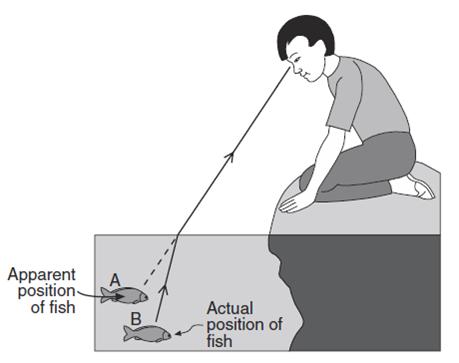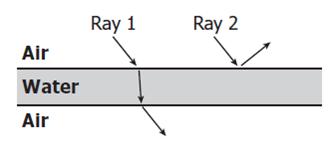|
Question 1.
|
|
The diagram below shows a boy observing a fish located at position B below the surface of the water. The boy sees the fish at position A. The apparent position of the fish is different from the actual position of the fish. What has happened to the light passing through the water to cause this difference? |
|
 |
| A |
refraction |
| B |
compression |
| C |
reflection |
| D |
absorption |
|
Question 2.
|
|
The diagram below shows a pencil in a glass of water. When viewed from the side, the pencil appears to be broken. What process causes this to happen? |
|
 |
| A |
absorption |
| B |
evaporation |
| C |
reflection |
| D |
refraction |
|
Question 3.
|
|
Which diagram shows the refraction of light as it enters water from the air? |
|
 |
|
Question 4.
|
|
Find out the speed of light in air. |
|
Question 5.
|
|
Two torches are turned on. The light rays they create are shown in the diagram. These light rays best illustrate that — |
|
 |
| A |
both rays are reflected |
| B |
both rays are refracted |
| C |
Ray 1 is reflected and Ray 2 is refracted |
| D |
Ray 1 is refracted and Ray 2 is reflected |
|
Question 6.
|
|
The eye has a lens inside it to focus the light onto the retina. As with all lenses, the lens in the eye bends the light to bring it a focus. The lens can change shape to cope with light from different distances away. Look at the diagrams below and decide which would bend the light the greatest. |
|
 |
|
Question 7.
|
|
Which of the following would reflect rather than refract light? |
| A |
Magnifying glass |
| B |
Mirror |
| C |
Prism |
| D |
Lens |
|
Question 8.
|
|
When white light is refracted through a prism, a spectrum is produced. |
|
 |
| a) |
Copy and complete the diagram below to show this phenomenon. |
| b) |
Which colour would be refracted the least? |
| c) |
Make up a mnemonic to remember the order of the colours in the spectrum? |

